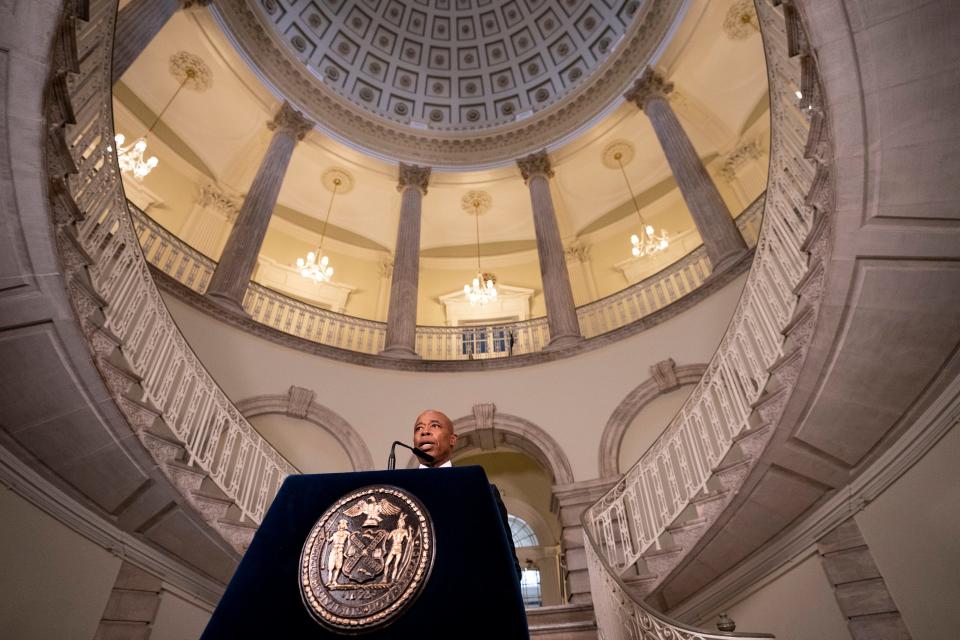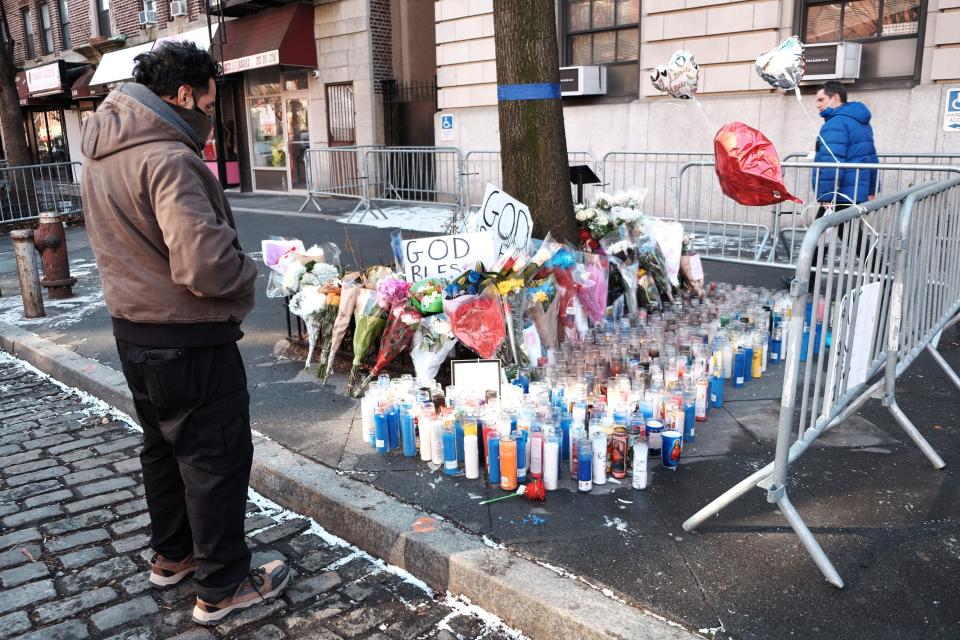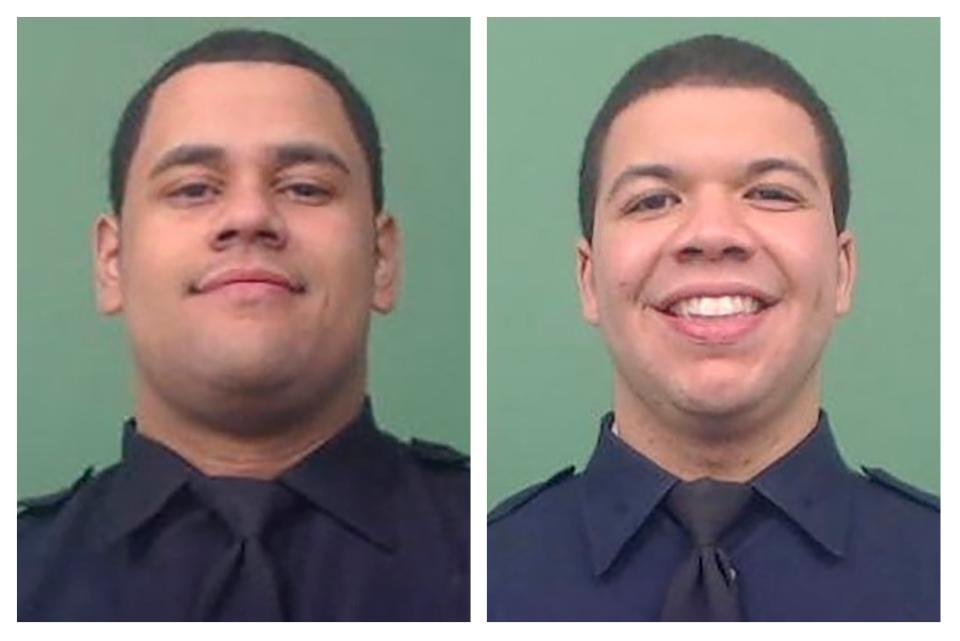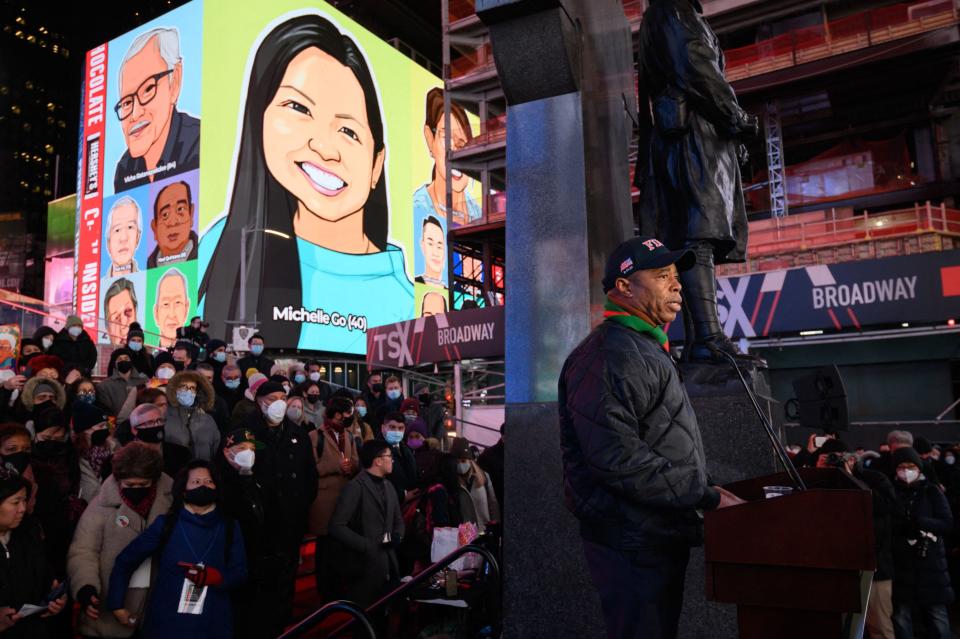No 'surrender': Mayor Eric Adams lays out gun violence plan after NYPD officers killed
- Oops!Something went wrong.Please try again later.
NEW YORK – Jason Rivera became a police officer to improve the relationship between the police in his hometown and its communities, he wrote in a letter while he was still a probationary officer waiting to join the New York City Police Department.
"Growing up in New York City, I realized how impactful my role as a police officer would go in this chaotic city," he explained.
Rivera, 22, was one of two police officers killed in the line of duty as they responded to a domestic dispute call on Friday, the latest in a spate of shootings of NYPD officers that has left New York and its public safety officials reeling as they search for answers to address crime in the city.
Officer Wilbert Mora, 27, died Tuesday after being hospitalized in critical condition for several days following the shooting, Police Commissioner Keechant Sewell said. He and Rivera were the third and fourth officers in less than a week to be shot while on duty in New York City. A fifth officer, who was off-duty, was also shot earlier this month.
Less than a month into his term, Mayor Eric Adams on Monday unveiled his strategy to combat gun violence, including reestablishing controversial anti-crime police units, calling for changes to alleviate a backlog of gun cases in the court system and addressing root causes of violence through all city agencies.
"New Yorkers feel as if a sea of violence is engulfing our city. But as your mayor, I promise you, I will not let this happen. We will not surrender our city to the violent few, and we won't go back to the bad old days," Adams said in a speech at City Hall.

While shootings in the city have increased since the start of the pandemic, they remain lower than the violent crime peaks of the 1980s and 1990s, according to police statistics. In the first two weeks of January in 1993, there were 253 shootings in the city, compared to 52 in the beginning of 2022. Since 2019, that number has increased every year, however, according to NYPD statistics.
Other high-profile shootings have also shaken some New Yorkers' fears around public safety in recent weeks, including an 11-month-old girl who was shot in the face last week as she sat in a parked car with her mother and a 19-year-old cashier who was shot to death as she worked a late-night shift.
Adams, a former police captain, acknowledged that New York remains far safer than many other big cities in the United States, "but we're not going to be satisfied with statistics. This isn't about other cities. This is about New York City."
Brian Higgins, an adjunct professor at John Jay College of Criminal Justice and former police chief in Bergen County, New Jersey, said while the uptick in shootings after the pandemic began may have been initially called a statistically blip, more deep-seated issues contributing to its cause remain.
"If there aren't changes in policing, I think this trend is going to continue," Higgins said.
JASON RIVERA: NYPD officer fatally shot in domestic disturbance call; second officer in grave condition
Disbanded anti-crime units return
During his policy speech Monday, Adams blamed the illegal flow of guns into the city for the shootings and called for federal and state help to address the "iron pipeline."
New York police officers recovered about 6,000 illegal guns last year, Adams said, yet many more are still flowing in. Federal and state funding and legislation are needed to address the problem, he said.
Among the policing measures Adams said his administration will implement to find firearms and arrest traffickers is the return of a controversial, plainclothes unit in the detective bureau, now called "Neighborhood Safety Teams."
Adams said the units would be identifiable as NYPD officers – such as by wearing police windbreaker jackets – but drive in unmarked cars to maintain an "element of surprise." The units will also have body-worn cameras, he said.
A prior iteration of the anti-crime units was disbanded in 2020 in what then-Police Commissioner Dermot Shea called a "seismic shift" in the department's culture. The units had been involved in a disproportionate number of shootings and complaints, Shea said, and were tied to the city's "stop and frisk" policy. An officer in an anti-crime unit also used a banned chokehold on Eric Garner, who died in 2014 during the encounter as he pleaded with officers that he couldn't breathe.

The teams will roll out over the next three weeks in 30 precincts where 80% of violence occurs, Adams said. The NYPD already has hundreds of candidates for the teams, according to the mayor's plan. The city will also hold listening tours in certain neighborhoods, "truly understanding the challenges" of past units, according to the mayor's plan.
Adams also called for increasing the use of facial recognition technology to track gun traffickers and adding "spot checks" at bus and train stations to find weapons entering the city.
STATE OF EMERGENCY: The US is seeing a summer surge in gun violence. New York just declared an emergency.
The mayor's plan also touched on non-policing approaches to combat gun violence. He said the city would name a coordinator in every city agency to focus on how that agency could contribute to the anti-gun violence efforts.
"We must address the root causes of these challenges and help our young people on a better path long before they pick up a gun," Adams said.
Adams proposed funding a summer jobs program to pay for internships for young people and more programs to bring jobs to targeted communities.
He also said he would reallocate resources in the Mayor’s Office of Community Mental Health for funding of homelessness programs as well as advocate for a law that would require people deemed to need medical care while experiencing a mental health crisis to be hospitalized if they refused, especially for those with a known history of violence.
Adams said more is needed to be done in the judicial system to alleviate a backlog of gun cases, too, such as calling on prosecutors to "triage" the outstanding gun cases they have
Patrick Lynch, the head of the city's largest police union, said Adams' plan "acknowledged the problem and outlined the beginnings of a plan." "Now that police officers and crime victims have an advocate in City Hall, the real work begins," he said in a statement.
Tiffany Cabán, a progressive council member who represents Queens, also praised Adams for addressing mental health and youth employment in the plan but said parts of it were "cause for deep concern," including the return of the plainclothes unit and the mayor's opposition to changes to bail laws.
William Evans, co-director of the Institute for Transformative Mentoring at the Center for New York City Affairs at the New school, said to address gun violence in the city, more resources were needed to empower credible messengers already in communities.
"There needs to be an intentional plan to go block by block," Evans said. "In the past there's always been a structure from the top down. Just recently, you have a lot of people practicing from the bottom up. … These are the people who are closest to the problem, and they're also the closes to the solution."
How Friday's shooting unfolded
Rivera, Mora and another officer were responding to a call for help from a mother who was in a dispute with her son around 6:15 p.m. Friday in Harlem, NYPD Chief of Detectives James Essig said at a news conference after the shooting.
No injuries or weapons were reported in the call, and when the officers responded, they spoke briefly with the mother and her other son, Essig said.
The other son, with whom the mother was having a dispute, was in the back bedroom at the time, Essig said.
Rivera and Mora went to check in the bedroom while the third officer stayed with the other family members, Essig said. When they walked down the "tight and narrow" hallway and approached the door, Lashawn J. McNeil, 47, began firing a Glock handgun, striking the two officers, Essig said.
As McNeil tried to flee, the third officer shot McNeil twice, in the arm and head, Essig said. McNeil died Monday after succumbing to his injuries, police said.

According to Essig, the Glock 45 pistol used in the shooting had a high-capacity magazine that could hold up to 40 shots, and the weapon had been stolen in Baltimore in 2017. On Monday, police said they also found a loaded AR-15 under the mattress after the executed a search warrant at the property.
Rivera joined NYPD in 2020, and Mora has been on the force for four years, police said.
MENTAL HEALTH CALLS: Pilot program will replace NYPD for mental health 911 calls in 2 neighborhoods
Essig said McNeil had several prior arrests, including a 2003 felony narcotics conviction in New York and a 2002 arrest for assaulting a police officer in Pennsylvania.
"It is our city against the killers," Adams said Friday just hours after the shooting. "This was just not an attack on three brave officers. This was an attack on the city of New York."
Earlier in the week, a police officer and a gunman in the Bronx were both wounded during a scuffle when the gunman fired a single bullet, authorities said. On Thursday in Staten Island, a narcotics detective was also shot in the leg while responding to a call.
On Jan. 1, an officer sleeping in his personal car in between shifts was shot in the head. Sewell said at the time the bullet had been fired at "a significant distance away" and it was unclear who the intended target was.
"Our department is hurting. Our city is hurting," Sewell said at the news conference Friday.
Rivera was the first New York City police officer fatally shot in the line of duty since Brian Mulkeen was struck by what police said was "friendly fire" as he struggled with a man in the Bronx in September 2019. In 2019, Detective Brian Simonsen was also killed in "friendly fire" while responding to a robbery in Queens. Officer Miosotis Familia was fatally shot in an ambush in the Bronx in 2018 as she sat in her marked police vehicle.
According to the National Law Enforcement Officers Memorial Fund, 61 officers around the country were fatally shot in the line of duty in 2021, a 36% increase from 2020 when 45 were fatally shot.
"Law enforcement fatalities equate to unsafe communities," said Marcia Ferranto, the CEO of the National Law Enforcement Officers Memorial Fund. "When you have the leaders of our country not supporting law enforcement, the unintended consequence is they are not supporting communities."
Other violent crime sparks concern
Before the recent string of crimes, Adams had vowed to make the city safer after worries about an uptick in shootings last summer.
Adams campaigned on a message of public safety, embracing more moderate policies some of his left-leaning primary opponents opposed, such as increasing police presence in high-crime neighborhoods and bringing back a version of "stop and frisk."
New York is one of five cities part of a federal task force aimed at curbing the spread of illegal gun trafficking that launched last summer under the Department of Justice alongside the Bureau of Alcohol, Tobacco, Firearms and Explosives and state and local law enforcement agencies.
Anthony Coley, a Justice Department spokesperson, said in a tweet Attorney General Merrick Garland had spoken with Sewell on Friday and the FBI was in touch with its NYPD counterpart.
In addition to the shootings, other violent assaults in New York City have raised alarms, including many targeted against people of Asian descent in a spate of rising hate crimes across the country.

At the Times Square subway stop on Jan. 15, Michelle Alyssa Go, an Asian American woman, was killed after being shoved onto the tracks in an unprovoked attack, police said. Prosecutors in the case said they were looking into whether racial bias may have played a role, but the suspect's attorney denied any link.
On Sunday, a man in Manhattan was also pushed onto the subway tracks but survived, police said. His attacker fled the scene.
Under former Mayor Bill de Blasio, the city rolled out a pilot program to replace police officers with EMTs and social workers in the response to some 911 calls for mental health crises.
Contributing: The Associated Press
This article originally appeared on USA TODAY: NYC Mayor Eric Adams lays out gun violence plan after NYPD deaths

